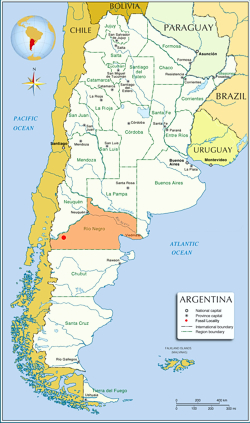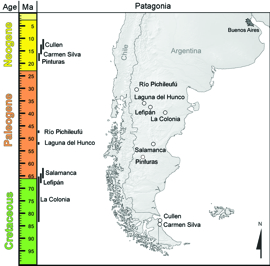The Río Pichileufú paleoflora is found about 100 miles (160 kilometers) northwest of the Laguna del Hunco paleoflora.  Dating of volcanic rocks associated with the fossil localities indicates that the flora is about 4.5 million years younger than the Laguna del Hunco flora, or about 47.5 million years old (early middle Eocene). The biota of the Río Pichileufú localities is diverse, and includes flowering plants, conifers, ants, and frogs. As at Laguna del Hunco, some of the plants show a connection to the modern flora of Australia and its surrounding region. The preservation of this flora is not as good as that of the Laguna del Hunco flora, thus, the Río Pichileufú flora has not been thoroughly studied. Because the Río Pichileufú flora is found near the Laguna del Hunco flora and because it is only slightly younger, it is especially valuable for understanding how the ancient flora of Patagonia may have changed over a very short period of time. Our work on Río Pichileufú centers on examining the flowering plant reproductive structures it shares with the Laguna del Hunco flora.
Dating of volcanic rocks associated with the fossil localities indicates that the flora is about 4.5 million years younger than the Laguna del Hunco flora, or about 47.5 million years old (early middle Eocene). The biota of the Río Pichileufú localities is diverse, and includes flowering plants, conifers, ants, and frogs. As at Laguna del Hunco, some of the plants show a connection to the modern flora of Australia and its surrounding region. The preservation of this flora is not as good as that of the Laguna del Hunco flora, thus, the Río Pichileufú flora has not been thoroughly studied. Because the Río Pichileufú flora is found near the Laguna del Hunco flora and because it is only slightly younger, it is especially valuable for understanding how the ancient flora of Patagonia may have changed over a very short period of time. Our work on Río Pichileufú centers on examining the flowering plant reproductive structures it shares with the Laguna del Hunco flora.
The Río Pichileufú fossil flora was discovered by J. R. Guiñazú and described for first time by Berry in 1938. The flora was preserved at the Ventana Formation, outcropping at the Río Negro Province, Patagonia, Argentina. The flora comprises flowers, fruits, seeds, and leaves and it is considered to be the most diverse Cenozoic flora of South America. The age of the Ventana Formation is calculated to be early Eocene.
Gandolfo Lab Research
Study of the Río Pichileufú flora is a collaborative project, with different teams of researchers taking the lead on different components. In the Gandolfo Lab, Dr. M. A. Gandolfo, students and post-docs are spearheading efforts to understand the systematics of the angiosperms—or flowering plants—based on reproductive material, which in the angiosperms including flower buds, flowers, fruits, seeds, and groupings of these structures (known as inflorescences for flowers and infructescences for fruits). Often, these structures are the most important for understanding the evolutionary relationships of flowering plants, and can give important clues to their biology.
Lab Work
Much of the detailed work involved in describing and understanding species of fossil plants takes place in the lab. We employ many traditional methods of paleobotanical study, such as making observations, describing fossil species, and comparing fossil species to living plants, in order to understand the plants that we find in the field. In addition, we use modern analytical techniques to attempt to gain a more precise understanding of the evolutionary relationships of fossil and living plants.
Other Paleofloras
(Youngest-Oldest)
- Cenozoic Paleofloras
- Cullen (middle Miocene)
- Carmen Silva (Miocene)
- Pinturas (late-early Miocene)
- Río Pichileufú (early-middle Eocene)
- Laguna del Hunco (Early Eocene)
- Salamanca (early Paleocene)
- Cretaceous Paleofloras
- Lefipán (Maastrichtian- 65.5-66 myo)
- La Colonia (Campanian to Maastrichtian)
Laguna del Hunco Information
Copyright © 2020 · All Rights Reserved
